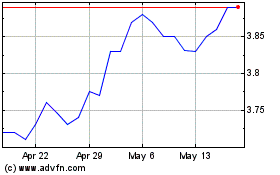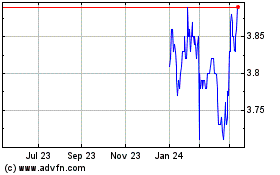Saba Capital Income & Opportunities Fund II (NYSE: SABA)
(the “Fund”), a registered closed-end management investment company
listed on the New York Stock Exchange (the “NYSE”), today announced
that its Board of Trustees (the “Board”) has approved (a) an open
market share repurchase program, (b) a reverse stock split, and (c)
subject to shareholder approval, an amendment to the Fund’s
Declaration of Trust to declassify the Board.
Open Market Repurchase Program. The Board has approved a
new open market share repurchase program to authorize the Fund to
purchase up to 10% of the Fund’s common shares each fiscal year
(provided, that the Board has reauthorized the repurchase program
in each subsequent fiscal year) in open market transactions, at the
discretion of the Fund’s investment adviser. The share repurchase
program is intended to increase the Fund’s net asset value (“NAV”)
to the benefit of all shareholders and help create further value
for shareholders by reducing the Fund’s discount to NAV.
Subject to the 10% limitation in a fiscal year, the timing and
amount of repurchases will be at the discretion of the Fund’s
investment adviser. In exercising its discretion consistent with
its portfolio management responsibilities, the investment adviser
will take into account various other factors, including, but not
limited to, the level of the discount, the Fund’s performance,
portfolio holdings, dividend history, market conditions, cash on
hand, the availability of other attractive investments, and whether
the sale of certain portfolio securities would be undesirable
because of liquidity concerns or because the sale might subject the
Fund to adverse tax consequences. Any repurchases would be made on
a national securities exchange at the prevailing market price,
subject to exchange requirements, federal securities laws and rules
that restrict repurchases.
If and when the Fund’s 10% threshold is reached in a fiscal
year, no further repurchases will be made (unless otherwise
authorized by the Board) for such fiscal year. The repurchase
program will require reauthorization by the Board for each new
fiscal year. Until the 10% threshold in a fiscal year is reached,
the investment adviser will have the flexibility to commence share
repurchases if and when it is determined to be appropriate in light
of prevailing circumstances.
Reverse Stock Split. The Board has approved a reverse
stock split (the “Reverse Split”) of the Fund’s common shares at a
ratio of 1-for-2. The Reverse Split is expected to become effective
immediately after the close of trading on the NYSE on June 21, 2024
(“Effective Date”), and the Fund’s common shares are expected to
begin trading on the NYSE on a reverse split-adjusted basis at the
open of trading on June 24, 2024.
As of the Effective Date, every two shares of the Fund’s issued
and outstanding common shares will be converted into one common
share. The Fund’s common shares will continue to trade on the NYSE
under the symbol “SABA.” The Fund also intends to issue fractional
shares in connection with the Reverse Split.
The Fund has also adopted an updated managed distribution plan.
In connection with the Reverse Split, the Fund’s fixed monthly
distribution will be adjusted from $0.029 per share to $0.058 per
share, beginning with the first distribution to be declared
following the Effective Date of the Reverse Split. Such adjustment
to the Fund’s fixed monthly distribution will result in no change
in monthly cash flow to shareholders.
Declassification of Board of Trustees. Subject to
shareholder approval at the next annual shareholder meeting, the
Board has approved an amendment to the Fund’s Declaration of Trust
to declassify the Board so that all trustees are elected on an
annual basis. The annual election of all trustees at once will
align the Fund’s corporate governance to the best-in-class standard
of the industry.
Past Performance is No Assurance of Future Results.
Investment return and principal value of an investment in the Fund
will fluctuate. Shares, when sold, may be worth more or less than
their original cost. Investors should consider the investment
objective, risks and expenses carefully. You can obtain the Fund’s
most recent periodic reports and filings by visiting
https://www.sec.gov/edgar/browse/?CIK=828803&owner=exclude.
Certain Risk Factors. The Fund’s investment objective is
to provide investors with high current income, with a secondary
goal of capital appreciation. There can be no assurance that the
Fund will meet its investment objective. The Fund seeks to achieve
this objective by investing globally in debt and equity securities
of public and private companies, which includes, among other
things, investments in closed‐end funds, reinsurance, and public
and private debt instruments. The Fund also may utilize derivatives
including but not limited to total return swaps, credit default
swaps, options (including but not limited to index options) and
futures, in seeking to enhance returns and/or to reduce portfolio
risk. In addition, on an opportunistic basis, the Fund may also
invest up to 15% of its total assets in private funds that focus on
debt, equity or other investments consistent with the Fund’s
investment objective.
The value of equity securities of public and private, listed and
unlisted companies and equity derivatives generally varies with the
performance of the issuer and movements in the equity markets more
generally. As a result, the Fund may suffer losses if it invests in
equity instruments of issuers whose performance diverges from the
Fund’s investment adviser’s expectations or if equity markets
generally move in a single direction and the Fund has not hedged
against such a general move. The Fund may invest in closed-end
funds, which are subject to additional risks and considerations.
The performance of reinsurance-related securities and the
reinsurance industry itself are tied to the occurrence of various
triggering events, including but not limited to weather, natural
disasters (hurricanes, earthquakes, etc.), non-natural large
catastrophes and other specified events causing physical and/or
economic loss. To the extent the Fund invests in
reinsurance-related securities for which a triggering event occurs,
losses associated with such event could result in losses to the
Fund’s investment, and a series of major triggering events
affecting a large portion of the reinsurance-related securities
held by the Fund could result in substantial losses to the Fund’s
investment. The Fund may invest in high yield securities, which are
speculative in nature and are subject to additional risk factors
such as increased possibility of default, illiquidity of the
security, and changes in value based on changes in interest rates.
Changes in short-term market interest rates may directly affect the
yield on the Fund’s common shares. If such rates fall, the Fund’s
yield may also fall. If interest rate spreads on bonds and loans
owned by the Fund decline in general, the yield on the bonds and
loans will likely fall and the value of such bonds and loans may
decrease. When short-term market interest rates rise, because of
the lag between changes in such short-term rates and the resetting
of the floating rates on bonds and loans in the Fund’s portfolio,
the impact of rising rates will be delayed to the extent of such
lag. Because of the limited secondary market for certain bonds and
loans, the Fund’s ability to sell such securities in a timely
fashion and/or at a favorable price may be limited. An increase in
the demand for bonds and loans may adversely affect the rate of
interest payable on new bonds and loans acquired by the Fund, and
it may also increase the price of bonds and loans purchased by the
Fund in the secondary market. A decrease in the demand for bonds
and loans may adversely affect the price of bonds and loans in the
Fund’s portfolio, which would cause the Fund’s NAV to decrease.
Investment in foreign borrowers involves special risks, including
but not limited to potentially less rigorous accounting
requirements, differing legal systems and potential political,
social and economic adversity. The Fund may engage in currency
exchange transactions to seek to hedge, as closely as practicable,
all of the economic impact to the Fund arising from foreign
currency fluctuations. Other risks include, but are not limited to,
the use of derivatives, the potential lack of diversification in
the Fund’s portfolio, and the fact that the Fund’s portfolio may be
concentrated in a small group of industries or industry sectors
from time to time. Investors should consult the Fund’s filings with
the Securities and Exchange Commission as well as the materials on
the Fund’s website for a more detailed discussion of these or other
risk factors that affect the Fund.
About Saba Capital Income & Opportunities Fund II.
Saba Capital Income & Opportunities Fund II is a
publicly-traded registered closed-end management investment
company. The Fund’s common shares trade on the NYSE under the
ticker symbol “SABA.” The Fund is managed by Saba Capital
Management, L.P.
Effective on January 1, 2024, Saba Capital Management, L.P.
replaced Franklin Templeton Advisers, Inc. as the investment
adviser to the Fund (formerly known as the Templeton Global Income
Fund). Performance of the Fund prior to January 1, 2024 is not
attributable to Saba Capital Management, L.P. The Fund has deployed
approximately 75% of its capital to date.
Forward-Looking Statements. This press release contains
forward-looking statements subject to the inherent uncertainties in
predicting future results and conditions. Any statements that are
not statements of historical fact (including but not limited to
statements containing the words “believes,” “plans,” “anticipates,”
“expects,” “estimates” and similar expressions) should also be
considered to be forward-looking statements. These statements are
not guarantees of future performance, conditions or results and
involve a number of risks and uncertainties. Certain factors could
cause actual results and conditions to differ materially from those
projected in these forward-looking statements. These factors,
including but not limited to the “Certain Risk Factors” noted
above, are identified from time to time in the Fund’s filings with
the Securities and Exchange Commission as well as the materials on
the Fund’s website. The Fund undertakes no obligation to update
such statements to reflect subsequent events, except as may be
required by law.
For further information on Saba Capital Income &
Opportunities Fund II, please visit our website at:
www.sabacef.com. On or around the end of May 2024, the website will
be updated to present portfolio information and other data as of
April 30, 2024.
View source
version on businesswire.com: https://www.businesswire.com/news/home/20240430048302/en/
800-468-9716
Saba Capital Income and ... (NYSE:SABA)
Historical Stock Chart
From Apr 2024 to May 2024

Saba Capital Income and ... (NYSE:SABA)
Historical Stock Chart
From May 2023 to May 2024
